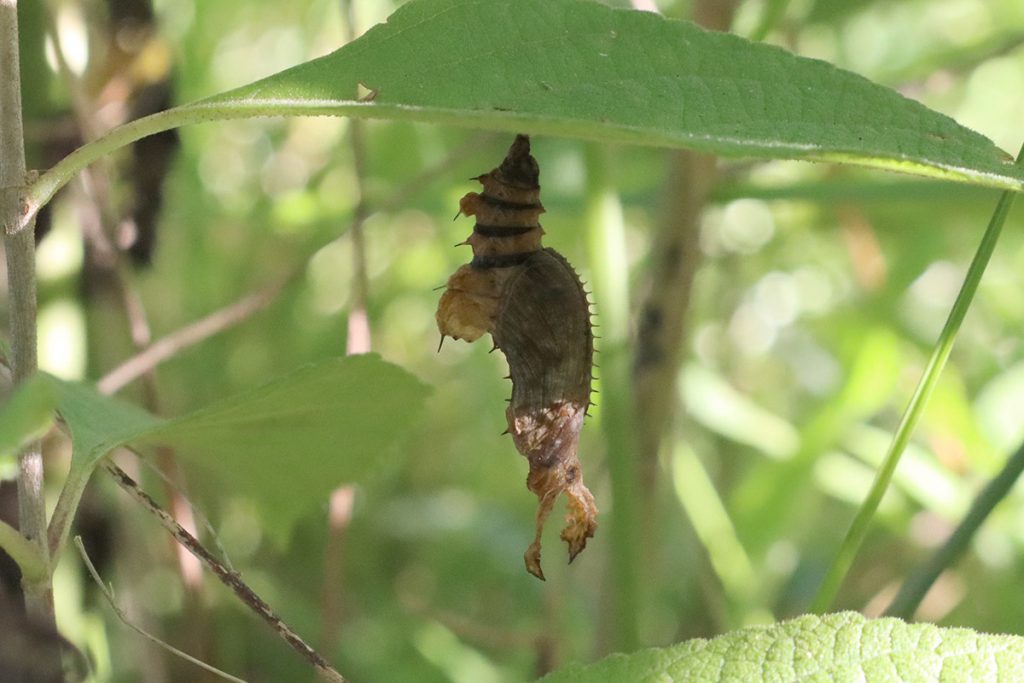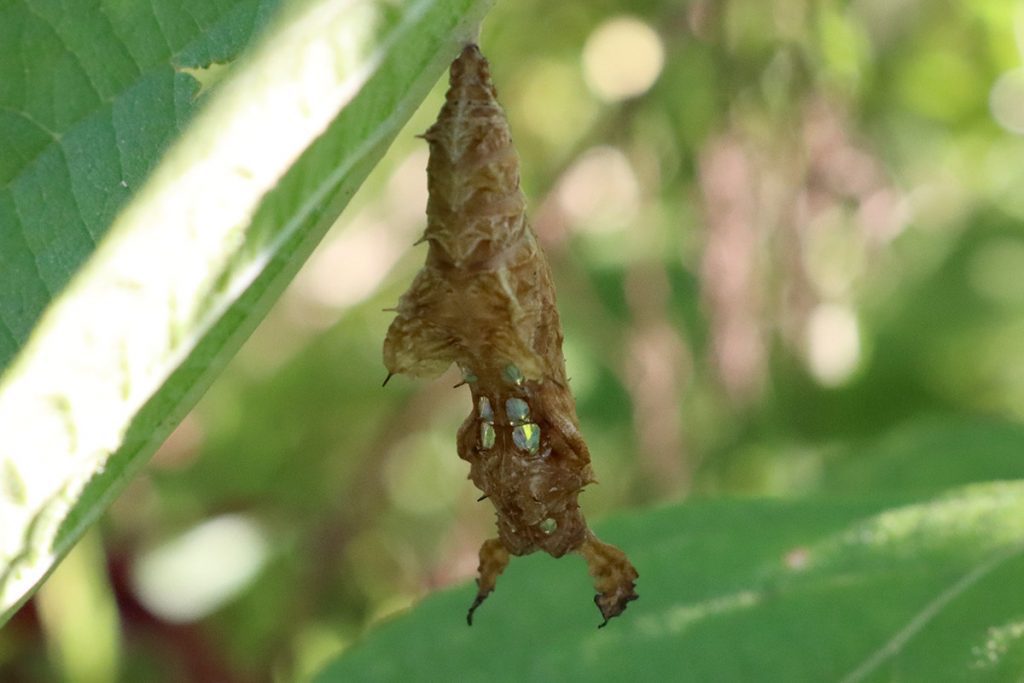Right now, my passionvine is leafless. In my first year with the plant, it grew in every direction. It spread underground and popped up in new places. It intertwined with several surrounding shrubs. Zebra longwings and gulf fritillaries carpet-bombed it with eggs, and for a good couple of months, dozens upon dozens of caterpillars had all the food they needed.
It was a good ride.
Like other butterfly larval food plants, it will rebound and leaf out again. Right now, though, I can reflect. I’ve already written about the gulf fritillary caterpillars we hosted on the passionvine, and their journey to butterflyhood. They came first, and in healthy numbers. After a few weeks, zebra longwings showed up, and with less restraint. Not only were there always scores of caterpillars, but we never had less than a dozen or so adult butterflies around the yard. If one of the vine’s growing tips was covered with eggs, they’d find space to lay one or two more.
Zebra longwings act like no other butterfly we’ve had in the yard. Other butterflies visit their larval food plants and leave, or I’ll see one or two visiting flowers. To have a dozen of them hang out for weeks on end is new for me, and it allowed me ample opportunity to observe them.
For the most part, they fed on the many flowers that bloomed in the late summer. Then, one day, I noticed them flocking to spots under beautyberry and Bidens alba leaves. When I crouched down to take a look, I started learning a few new things about butterfly mating behavior.
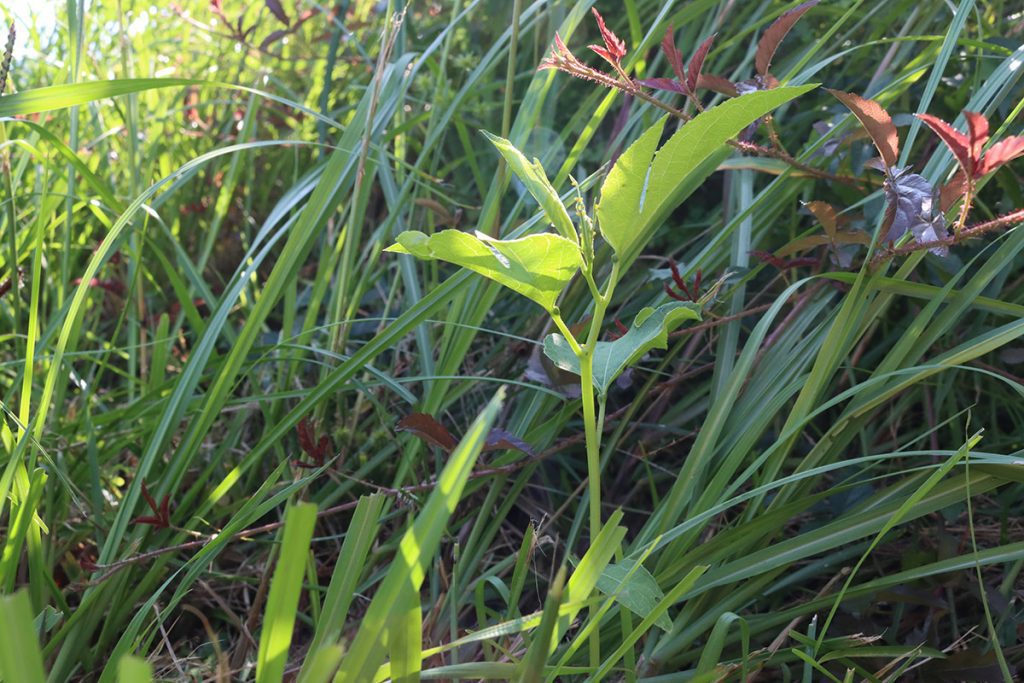
The All You Can Eat Passionflower Buffet
I planted passionflower in part because zebra longwings have not always been common in my yard. And I wanted to see a new (to me) caterpillar species do its thing. Every butterfly species, and its caterpillars, behaves in its own way. Long-tailed skipper caterpillars-bean rollers- spend their days tucked into rolled up sections of bean plant leaves, coming out at night to eat. Swallowtail species stick out a snake-like tongue when bothered. Monarchs often leave their milkweed plants when not eating, seeking shelter away from those paper wasps that are always raiding the plants. Learn more about each of these caterpillars in this 2019 post.
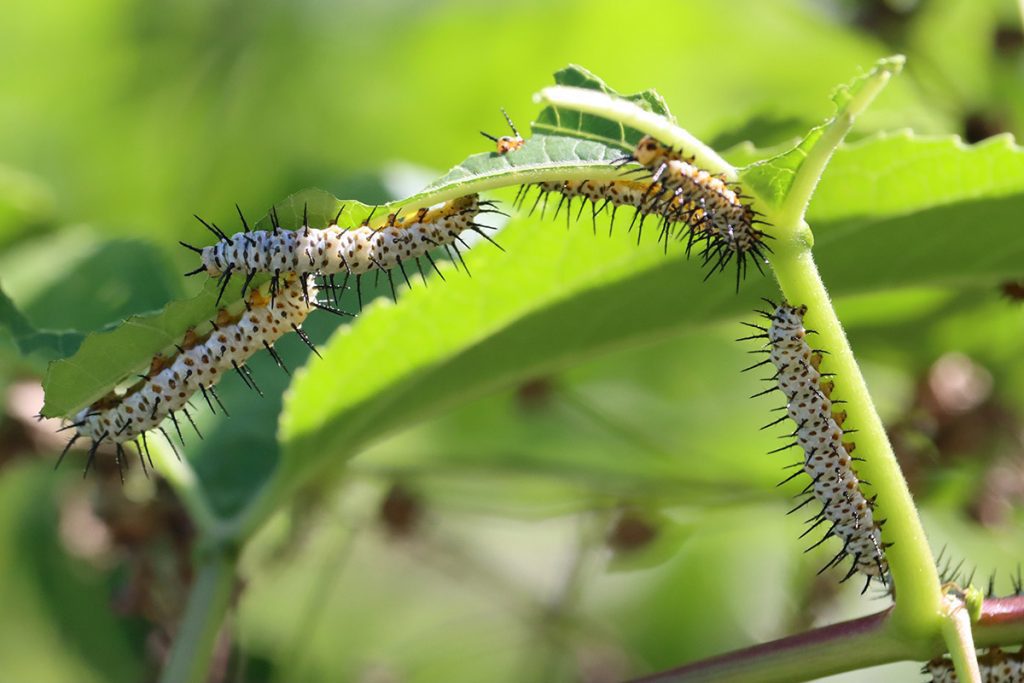
Perhaps because of their spikey appearance, zebra longwing caterpillars hang out in the open, in large numbers. Their spines are, in fact, nonvenomous. Their appearance likely keeps a few predators away, but not all:
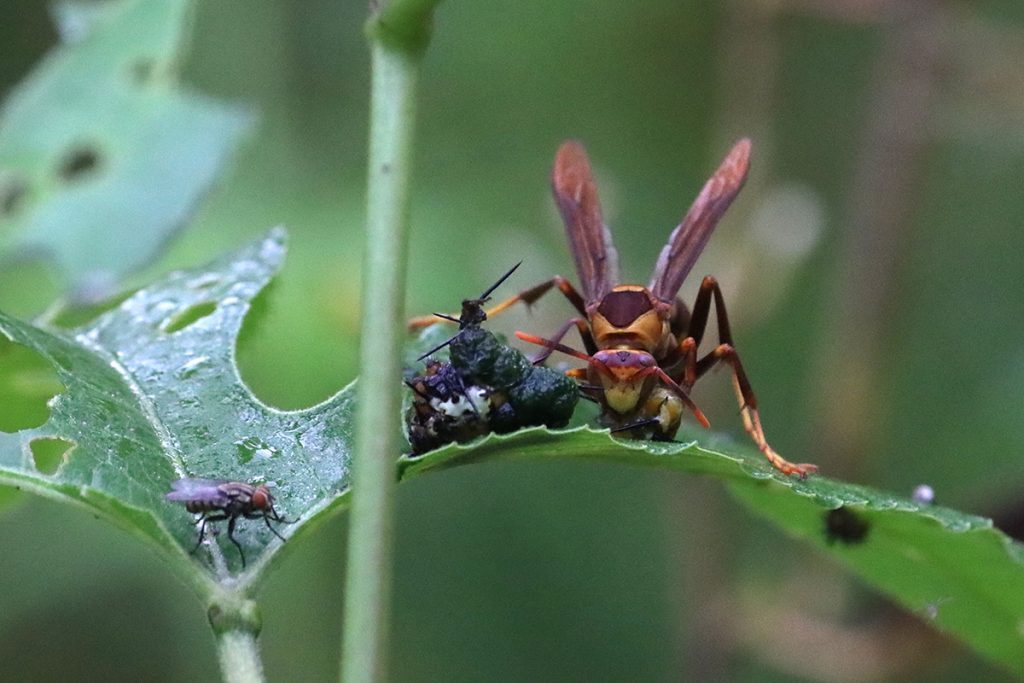
I saw quite a few chewed up caterpillars on the passionvine- but so many more live ones. I’ve never seen such a volume of butterfly caterpillars at a time (moths yes, but not butterflies). And it was neat seeing two different, closely related species share the plant.
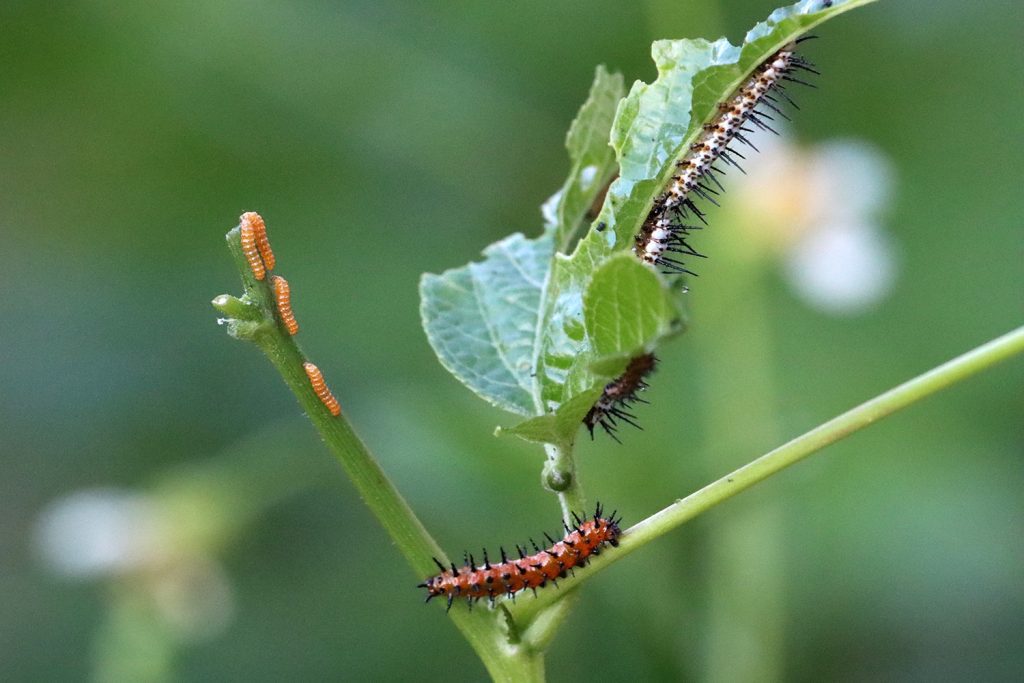
Not every caterpillar becomes a butterfly. As I keep repeating, if only two out of the dozens of eggs laid make it to adulthood, then their parents have been replaced and they maintain a stable population. The others become an important part of the food web. I focus on pollinators a lot when I write, but for our urban/ suburban ecosystems to maintain birds and other larger critters, they need insects to eat.
Caterpillars are a favorite food of birds, especially nestlings. But, as we’ll see, adult butterflies are a part of the food web as well.
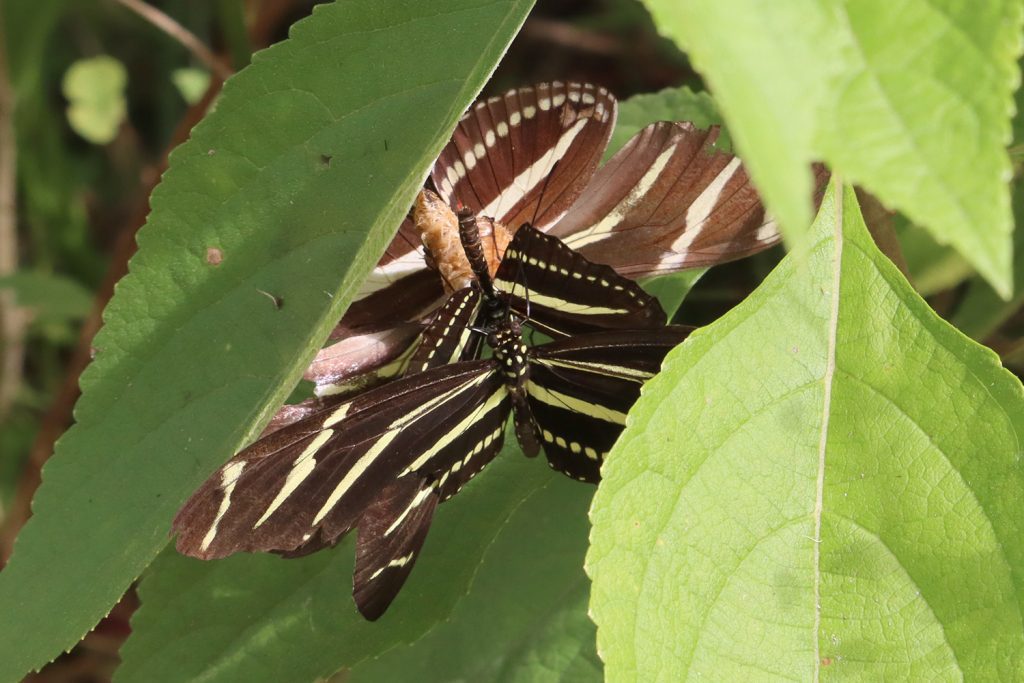
So, what are those Zebra Longwings doing down there?
Back to those zebra longwing adults hanging out under beautyberry and Bidens alba leaves.
When I crouched down to look, I saw a butterfly hanging from a chrysalis. It must have just eclosed, I thought. It flew off, but then it came back. And then a second one joined it, followed by a third. I had never seen this kind of thing before. I took photos as I always do, and when I zoomed in, I saw that this chrysalis was still occupied.
Neither of these butterflies eclosed from the chrysalis. They were just… hanging out on it.
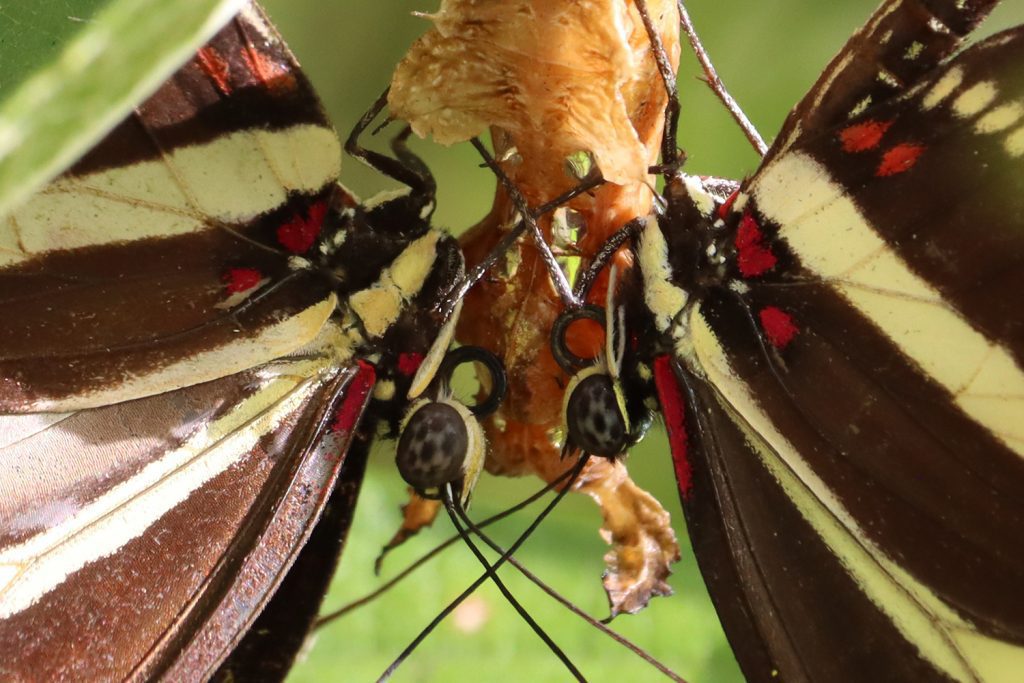
I Googled it and found that male zebra longwings will hang onto chrysalises and wait for females to eclose. There were four or five chrysalises in these shrubs with butterflies hanging off of them, and a couple more without (the males?). I knew gulf fritillaries would travel to make a chrysalis, but these were in the same wildflower patch as the passionvine. The more I looked, the more I saw.
That day, I also saw this:
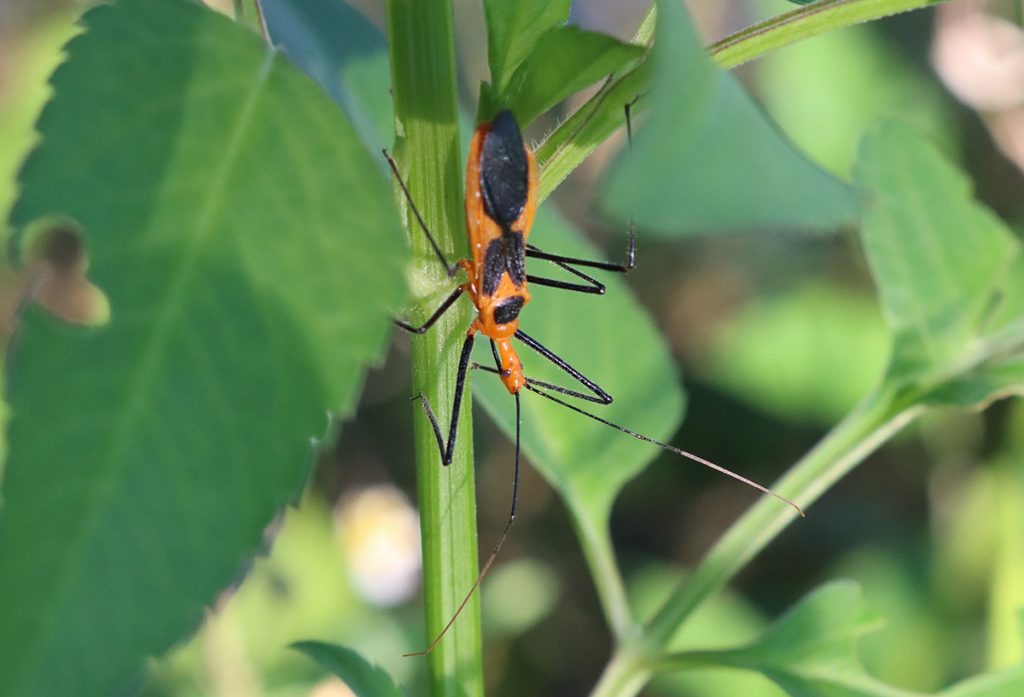
Someone had recently left a comment on another post, about monarch predators, saying she had seen an assassin bug “suck the juices” from a monarch chrysalis. And here was one within a few feet of several chrysalises. Were the ones cluttered with males safer from this assassin than the others?
A Tragic End to a Short-Lived Affair
I had a choice to make. I could tend to deadlines for grant funded projects, or I could set up a camera and wait for a female to eclose, filming the males fighting for her as she entered the world as a butterfly. That, of course, could take all day. So, no, that wasn’t really a choice.
I did check back periodically. Two males hung on one chrysalis for one whole day, and when I returned from dropping the kids at school the next day, they were still there. This was going to happen soon. I popped back out half-an-hour later and saw this:
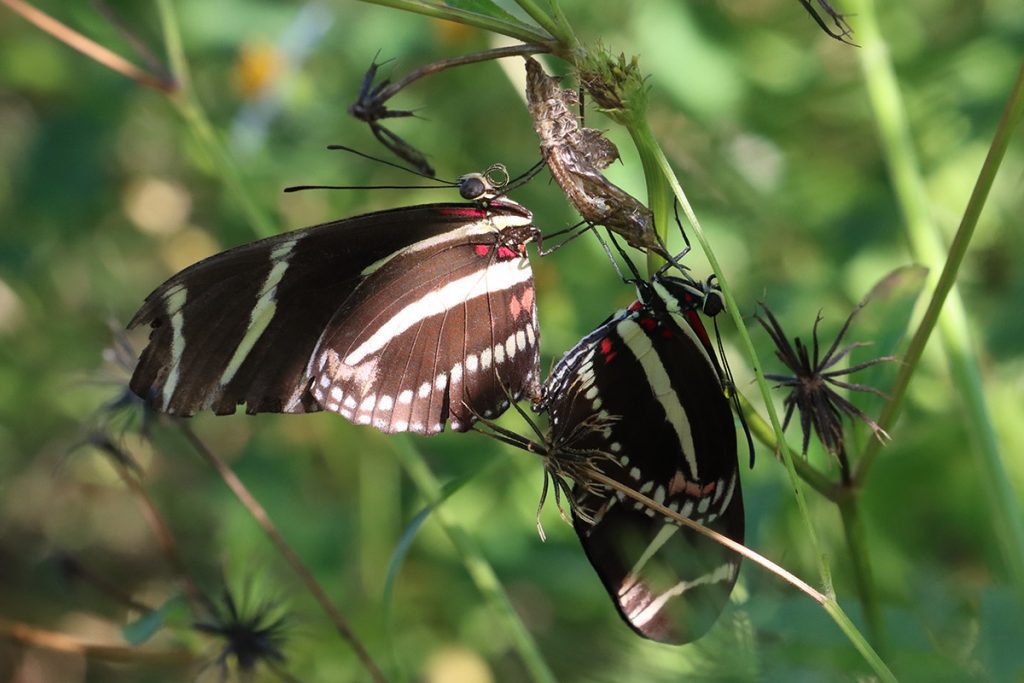
As I snapped photographs, I noticed a new insect had joined the proceedings:
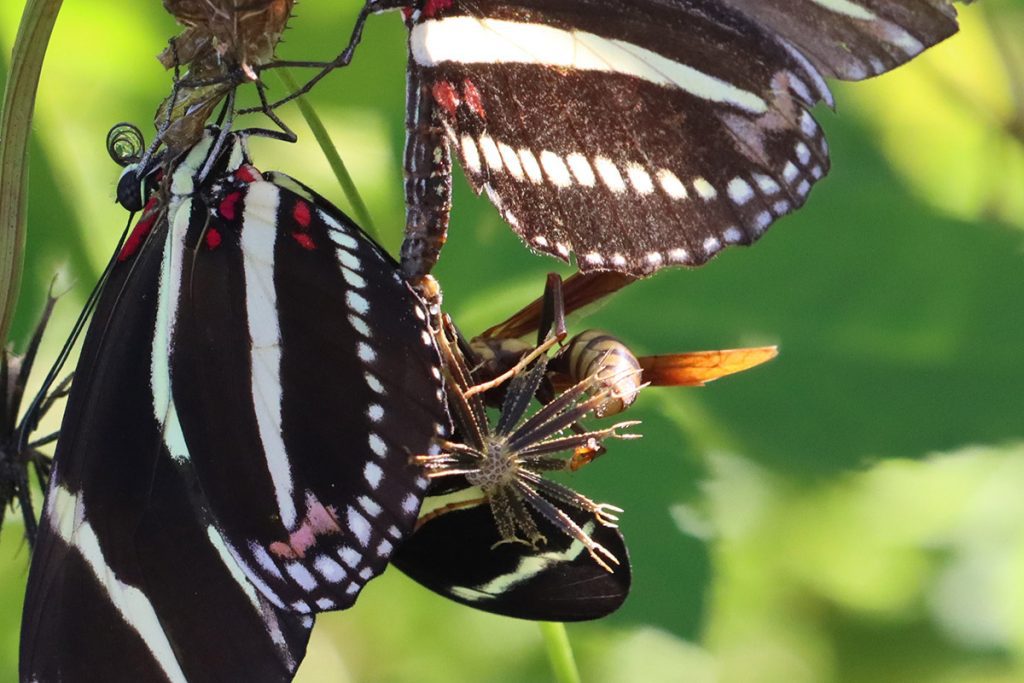
In this photo, you can see how much more vibrantly colored and clean looking the one butterfly is compared to the other. One of these butterflies has been out in the world, fending for itself. That would be the male. This female had just entered the world as a butterfly, and, likely after a short fight between the males, immediately started mating. Within a few more moments, she was viciously attacked by a predator.
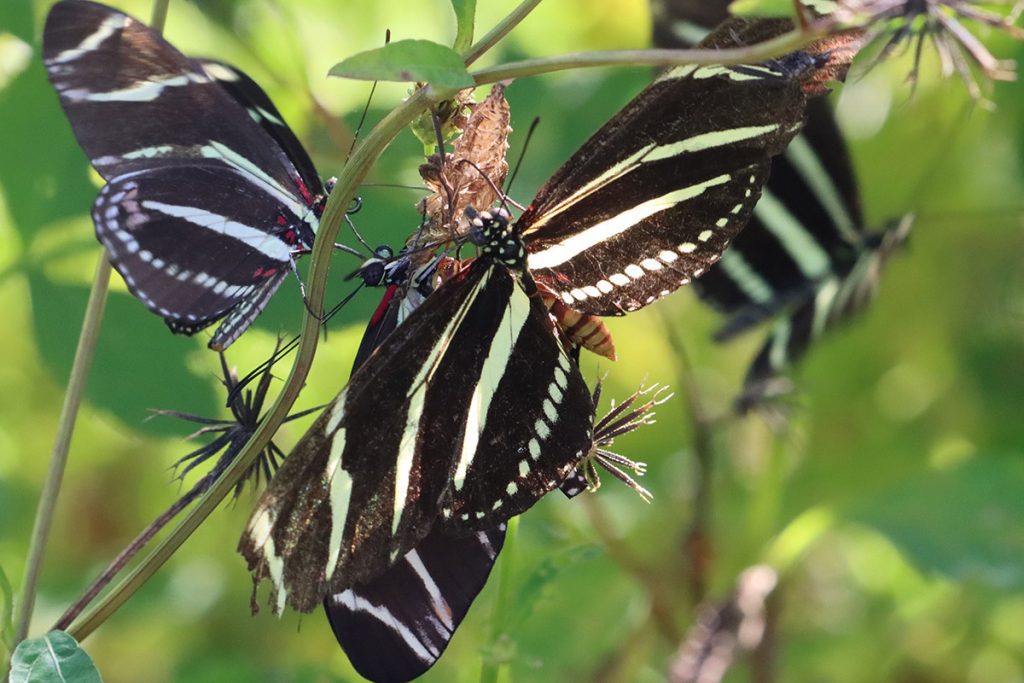
I wonder if the intervening butterflies in the photo above were trying to stop the assault, or trying to knock the male off to mate with the female themselves. The chemical cue to mate is strong; Florida Native Plant Society’s Lilly Anderson-Messec says that not only do other species hang on chrysalides waiting for females, but that she’s seen males try to mate with dead females.
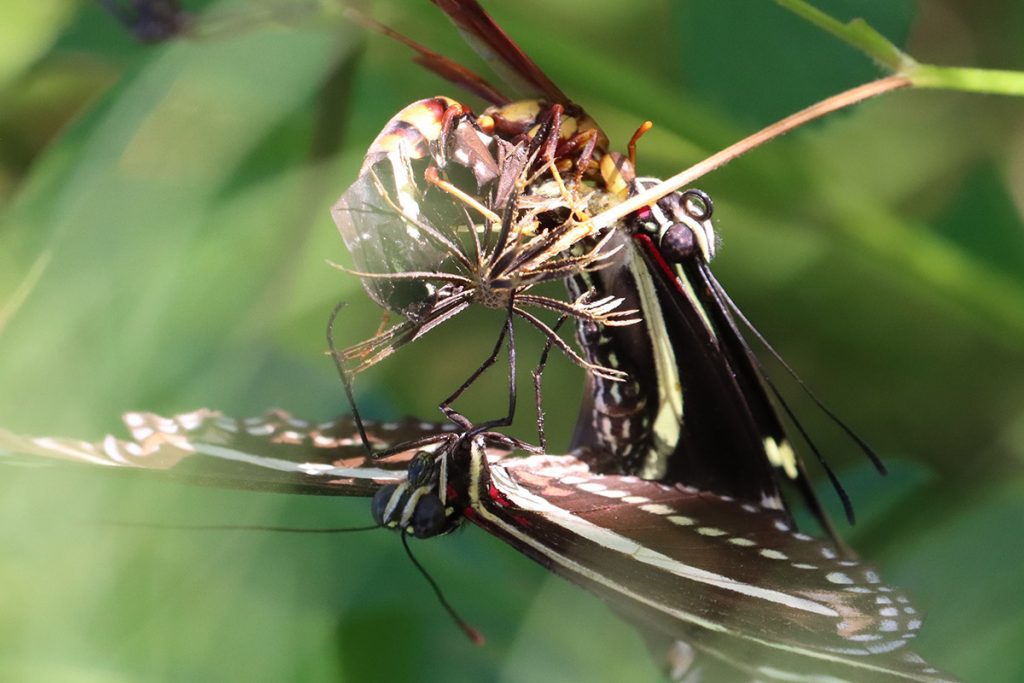
I hadn’t seen this species of paper wasp until this year- it’s the same species that ate into the caterpillar in the photo above. It might be a horse’s paper wasp, Polistes major. I have seen other paper wasp species eating black swallowtail and monarch caterpillars.
As the female was being eaten, the male did not seem to notice, not at first, anyway. When he did notice, he found himself stuck. He flailed a while until breaking free. Well, not entirely free:
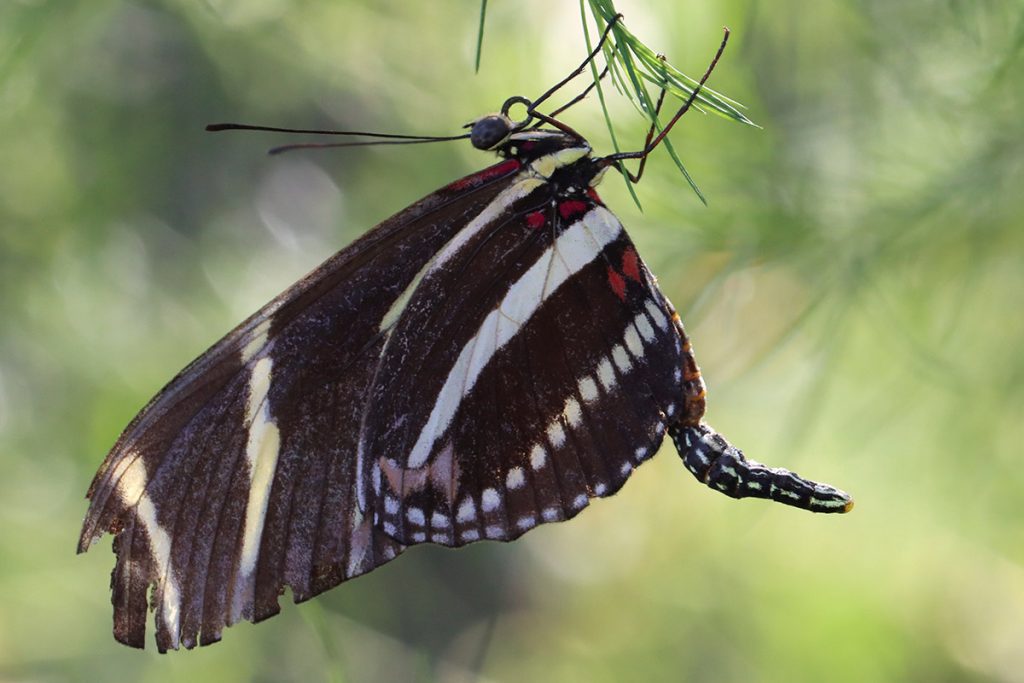
As the male flew away from the dog fennel, other butterflies began to pursue him. Did they smell the little bit of the female still stuck to him?
Build your garden as a theater, and let the actors play out their drama
I’ve written a bit about caterpillars meeting their ends in my yard. I feel like a little bit of a ghoul. But not really.
A couple of years ago, I was interviewing The Nature Conservancy’s Brian Pelc about sandhill restoration. The purpose of restoration is to return something to its previous state- in this case before forests were clear cut for timber. The problem is that climate change makes it unlikely that it could ever return to what it had been a couple hundred years ago. Some different plants and animals would thrive in a warmer, drier climate, and perhaps some species would shift northward.
What Brian told me was that when TNC restores habitat, they treat it like they’re building a theater. They can’t control everything that happens on stage; the important thing is that there is a stage on which the drama can play itself out.
In a sandhill habitat, this means establishing a grassy understory, planting longleaf pine, and managing it with regular fire. This is the foundation. The individual players may change, but all humans have to do is maintain the stage for them.
Since then, I’ve come to regard the garden as a stage.
I give as much space as I can afford to native plants, whether I buy them, grow them from seed, or they grow as weeds. I let leaves lie in the winter, and I try to leave bare patches of soil for ground nesting insects such as bees. If a dewberry vine or Bidens alba bush encroaches on wildflowers I planted, I cut them back. And I water when I need to.
Once that stage is set, I can’t control- nor should I try to control- what insects do. I’m not talking about your vegetable garden, though I largely take the same approach there. In your backyard ecosystem, some insects eat plants, or take nectar from their flowers. Those insects are, in turn, consumed by predatory insects, spiders, songbirds, lizards, possums, frogs. Some of those animals are eaten by hawks, owls, or snakes. But it all starts with insects. And insects need native plants.
A couple of weeks ago, I saw a site that gave me a little jolt:
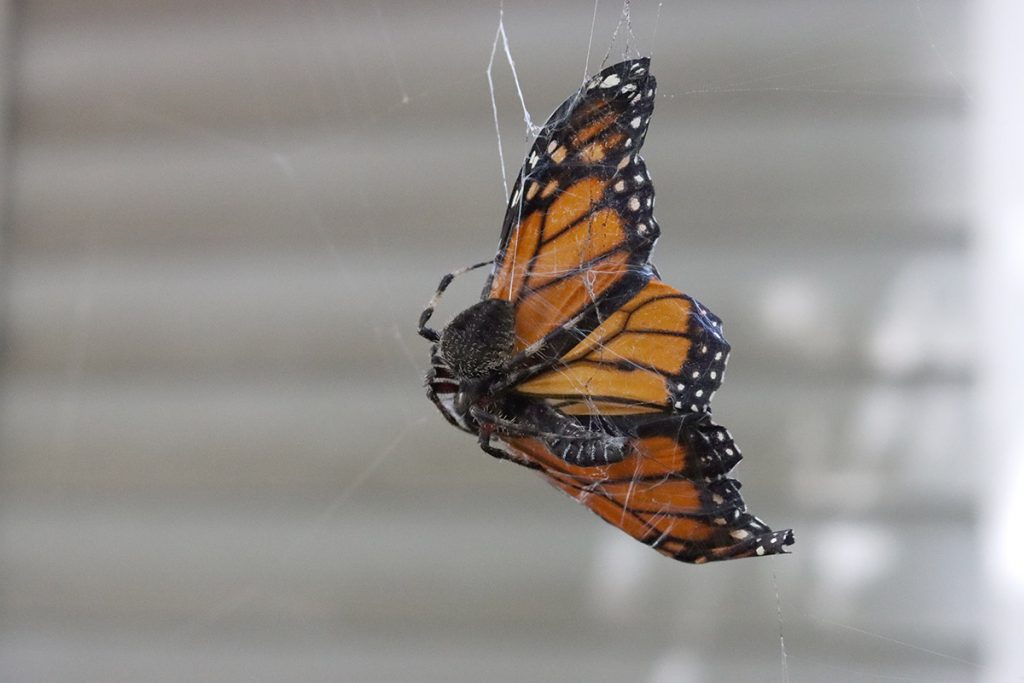
A few weeks after they were declared internationally endangered, here a monarch butterfly has met its end in my yard. I’ve planted milkweed for years, and seen dozens of their caterpillars grow and metamorphose into adulthood. We try to help this animal, and so it’s not a happy thing to see one get eaten.
Here’s the thing:
If I see a dead monarch in my yard, it’s because I have habitat for monarchs in my yard.
This year and last, late summer is crazy time for monarchs in my yard. This is when Brickellia cordifolia blooms. A native wildflower listed as endangered in Florida, it produces pink flowers for about a month from about late August through mid-September. And when it blooms, several bees and butterflies go gaga for it, especially monarchs.
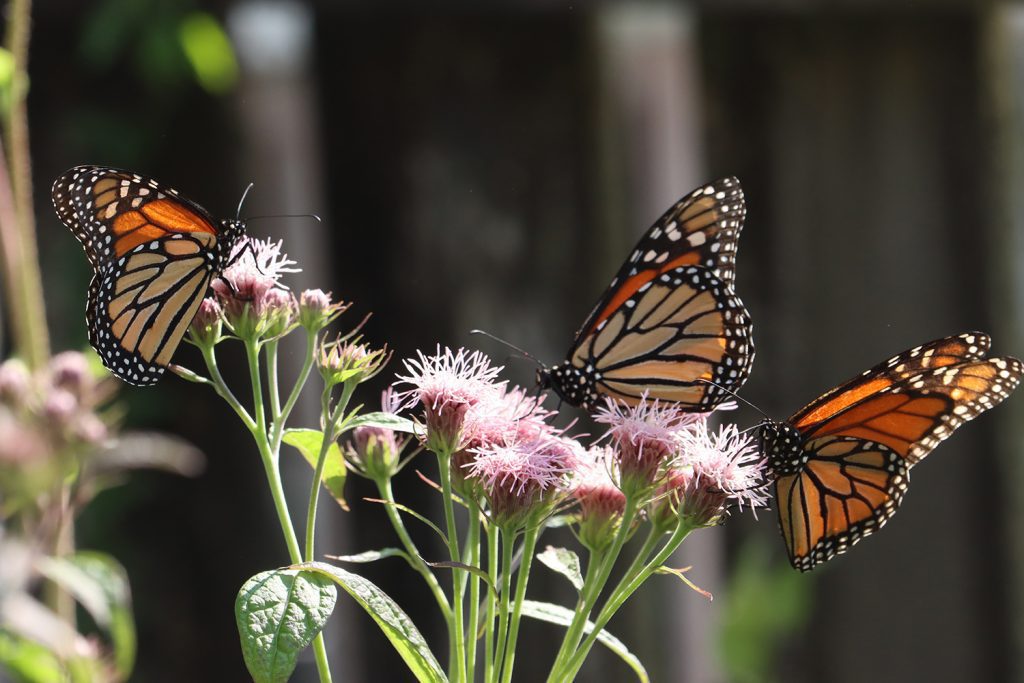
Not only do they love the flowers, but it seems the flowers make them fall in love. Well, no, not love. But they sure do start mating a lot on and around the plants. It must bloom at some peak of their multigenerational northward migration. Like they did in September of last year, they mated, and mated some more, and the resulting caterpillars ate our milkweed plants down to their stems.
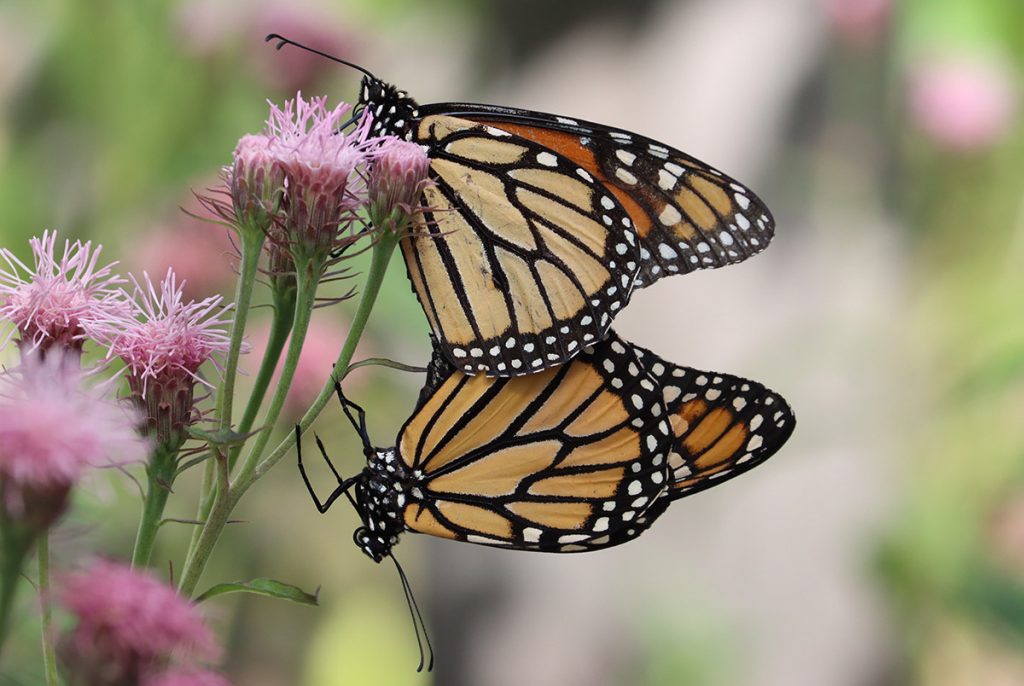
I feel like I’ve seen more death in my yard this year than in other years, but that’s because there’s so much more life in my yard than in other years. I simply have way more wildflowers and other native plants than I’ve ever had. If you don’t want to see dead butterflies and caterpillars, don’t plant any wildflowers or larval food plants.
I’ve seen people get discouraged because they don’t see many caterpillars make it to adulthood in their yards. The thing is, you’ve created a space for them that otherwise wouldn’t exist in an urban/ suburban setting. We see up years and we see down years, but we can’t get hung up on how many caterpillars we see make it or not make it in a given year. If more of us create a backyard habitat, there are more places where a butterfly can lay its eggs. This makes the species, and the insect population in your area overall, more resilient.
You’re still helping.
And not only are you helping, but you’ve set a stage where you yourself can watch some real life and death drama, a little bit of “romance,” and some weird, wild stuff.

